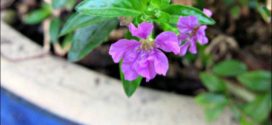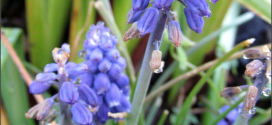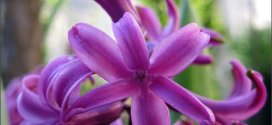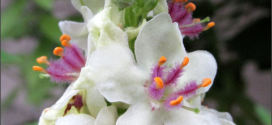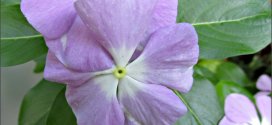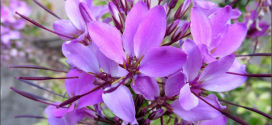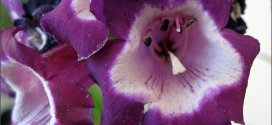Cuphea hyssopifolia, commonly called Mexican heather, is native from Mexico to Guatemala. It is a rounded, densely branched 1-2’ tall tropical sub-shrub. It produces quaint, small, trumpet-shaped flowers with six spreading lavender petals and green calyx tubes. Flowers appear singly in the leaf axils along stems crowded with lance-shaped glossy green leaves (to 3/4” long). Blooms profusely summer to frost. …
Read More »Tag Archives: purple
Muscari – Grape Hyacinth
Grape Hyacinth is one of the first spring flowers and has a great fragrance. The first time you plant them should be in November. The plants naturalize (meaning that the next year’s flowers are the same). Severe poisoning from hyacinth or tulip poisoning is often seen when dogs dig up freshly planted bulbs or having access to a large bag …
Read More »Pansy
Pansy, Viola x wittrockiana Family: Violaceae (vy-oh-LAY-see-ee) (Info) Genus: Viola (vy-OH-la) (Info) Species: x wittrockiana (wit-rok-ee-AH-na) (Info) Category: Annuals Tropicals and Tender Perennials Height: under 6 in. (15 cm) 6-12 in. (15-30 cm) Spacing: 6-9 in. (15-22 cm) Hardiness: USDA Zone 7a: to -17.7 °C (0 °F) USDA Zone 7b: to -14.9 °C (5 °F) …
Read More »Hyacinth
Dutch Hyacinth, Hyacinthus orientalis. Attractive to bees, butterflies and/or birds. Flowers are fragrant. This plant is suitable for growing indoors. Average Water Needs; Water regularly; do not overwater. Flowers are good for cutting Severe poisoning from hyacinth or tulip poisoning is often seen when dogs dig up freshly planted bulbs or having access to a large bag of them. When …
Read More »Verbascum chaixii
We first planted our verbascum in October 2014. It had a late season flowering. In June 2015, it bloomed again. Do not plant other things within 2 feet of it as it has large leaves. Erect stems bearing profuse saucer-shaped flowers that are usually yellow, but also white, brownish-red, or purple. Individual flowers are short lived but numerous, and flowering …
Read More »Vinca
Common Periwinkle, Creeping Myrtle, Flower-of-Death, Vinca minor Family: Apocynaceae (a-pos-ih-NAY-see-ee) (Info) Genus: Vinca (VIN-kuh) (Info) Species: minor (MY-nor) (Info) Category: Groundcovers Perennials Height: under 6 in. (15 cm) 6-12 in. (15-30 cm) Spacing: 15-18 in. (38-45 cm) Hardiness: USDA Zone 4a: to -34.4 °C (-30 °F) USDA Zone 4b: to -31.6 °C (-25 °F) USDA …
Read More »Cleome – Senorita Rosalita
Spider Flower, Spider Legs, Grandfather’s Whiskers, Cleome houtteana Family: Cleomaceae Genus: Cleome (klee-OH-me) (Info) Species: houtteana (hoot-AH-na) (Info) Synonym:Cleome hassleriana Synonym:Cleome sesquiorygalis Synonym:Tarenaya hassleriana Synonym:Cleome spinosa Synonym:Neocleome spinosa Category: Annuals Height: 36-48 in. (90-120 cm) Spacing: 18-24 in. (45-60 cm) Hardiness: Not Applicable Sun Exposure: Full Sun Danger: Plant has spines or …
Read More »Calandrinia Spectabilis
Calandrinia is a plant genus that contains many species of purslane, including the redmaids. The genus was named for Jean Louis Calandrini, an 18th-century Swiss botanist. It includes around 150 species of annual herbs which bear colorful flowers in shades of red to purple and white. Plants of this genus are native to Australia, Chile, and western North America. This …
Read More »Penstamon – Purple
Penstemon is a western United States native that has colorful tubular flowers on tall spikes. This prairie plant thrives in hot, sunny conditions and is a stunning addition to wildflower plantings. Another common name is beardtongue. About This Plant Penstemon forms dense spikes of tubular flowers in early to mid summer. Flower colors include pink, blue, red, purple, and white. …
Read More »Primrose
English Primrose, Primula vulgaris Family: Primulaceae Genus: Primula (PRIM-yew-luh) (Info) Species: vulgaris (vul-GAIR-iss) (Info) Synonym:Primula acaulis Synonym:Primula malacoides Category: Alpines and Rock Gardens Perennials Height: under 6 in. (15 cm) 6-12 in. (15-30 cm) Spacing: 12-15 in. (30-38 cm) 15-18 in. (38-45 cm) Hardiness: USDA Zone 4a: to -34.4 °C (-30 °F) USDA Zone …
Read More »